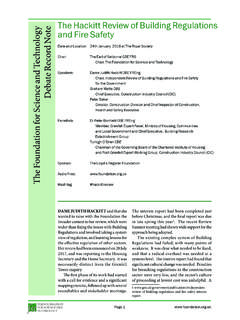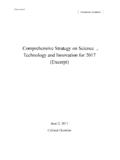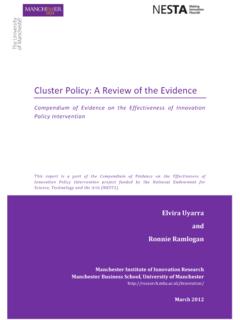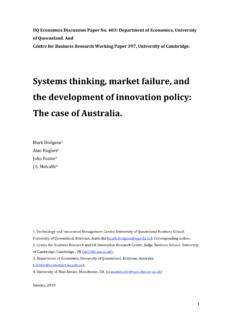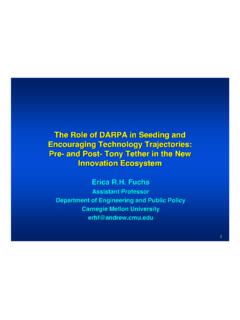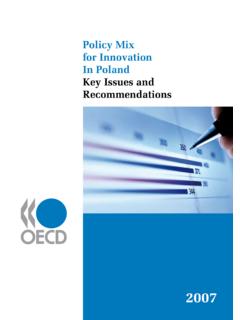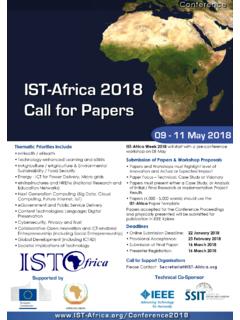Transcription of UKRI leaves the starting blocks: the management of ...
1 1 UKRI leaves the starting blocks: the management of government funding of research and innovationDate and Location: 28th February, 2018 at The Royal SocietyChair: Professor The Lord Mair CBE FRS FREng Council Member, The Foundation for Science and TechnologySpeakers: Sir Mark Walport FRS FMedSci HonFRSE Chief Executive, UK Research and innovation (UKRI) Sir Alan Wilson FBA FAcSS FRS Chief Executive, The Alan Turing Institute Panellists: Kirsten Bound Executive Director of Research Analysis and Policy, Nesta Jonathan Neale Chief Operating Officer, McLaren Technology Group Ltd Sponsors: Association for innovation , Research and Technology Organisations (AIRTO), The Comino Foundation, The Peter Jost Charitable FoundationAudio Files: tag: #fstukri The Foundation for Science and TechnologyDebate Record NoteSIR MARK WALPORT opened by describing the drivers behind the creation of UK Research and innovation (UKRI) and its new strategy.
2 The world was changing: population growth, rising from 7 to 9 billion over the next 30-40 years; changing demographics, with growing younger populations in Africa, South Asian and South America driving new patterns of migration; the indelible impact of the Anthropocene era on the globe itself, including, for example, the emergent issue of plastics waste. All these presented grand challenges for science and innovation . The world of science itself was also changing with new research tools, big data, an increasing emphasis on interdisciplinarity and the scope for international collaboration all combining to offer the prospect of solutions to those grand world of business was changing. We were in the throes of what was, arguably, the fourth industrial revolution: characterised by the fusion of physical, digital and biological science, the power of data, the blurring of manufacture and services and what was sometimes described as the circular economy in which waste was converted into positive resources.
3 All this had pointed up the need for a new industrial strategy, founded on strong , society was changing in ways which mean that public engagement would be a key issue for UKRI: establishing trustworthiness at a time of increasing mistrust of the establishment and of experts; engaging with the role of social media and the implications of globalisation; and facing into the ethical challenges often posed by science where science meets values . UKRI had therefore set itself two high level objectives: delivering economic impact and social prosperity; and an enriched, healthier, more resilient and sustainable society. Everything UKRI delivered had, Page the end, to contribute to one or both of those objectives. They were, however, supported by three other objectives: pushing the frontiers of human knowledge and understanding; creating the best environment for research innovation ; and ensuring that UKRI itself was an outstanding organisation.
4 Sir Mark then outlined (in alphabetical order) nine early priorities for UKRI. The first related to the Industrial Strategy Challenge Fund (ICSF). Six challenges had already been announced against a funding commitment of 725m for a second wave of the ICSF: prospering from the energy revolution; transforming constructions; transforming food production; data and early diagnosis in precision medicine; healthy ageing; and the audience of the future. Pioneer challenges had also been launched on next generation services and quantum technologies; and expressions of interest had just been invited for a third wave of ICSF calling for industry led consortia to come forward with major industrial and societal Infrastructure Roadmap was being created looking ahead to 2030, based on existing UK infrastructure and future requirements. It would be a collaborative exercise covering all disciplines and key assets supporting research and innovation , including publicly funded and accessible infrastructure supported by UKRI and beyond.
5 innovation and Commercialisation was clearly a priority for Innovate UK, but not exclusive to that arm of UKRI. It would involve cross cutting funds which spanned research and innovation ; navigating the complex knowledge exchange landscape; facilitating collaborative partnerships between business, universities and teachers; and developing business support mechanism and the Catapult network. Another priority for UKRI was on International Collaboration . A new International Research and innovation Strategy , on which UKRI had worked closely with the Department for Business, Energy and Industrial Strategy (BEIS), would be published shortly. There was a 110m fund for international collaborations; and within UKRI, international strategy and policies (including cross-council activities such as Global Challenges Research Fund (GCRF) and the Newton Fund) would be managed centrally.
6 Regional innovation and growth would be driven by a 115m Strength in Places Fund , reflecting the growing importance of the place agenda in the light of the uneven geographical distribution of research and innovation resource within the UK. The aim would be to support regional growth by identifying and supporting areas of emerging R+D strength and to grow the capacity of existing research excellence and high quality innovation in identified further priority areas were the Strategic Priorities Fund , and supporting research and Research Talent . The former built on Sir Paul Nurse s vision of a common fund, aimed at supporting high quality strategic R+D priorities which would otherwise have been missed and working with researches and businesses to identify multi and interdisciplinary programmes. The latter would see 300m invested over the next three years in world class talent.
7 This would provide for new cohorts of PHDs and what were being described as knowledge transfer partnership positions with the emphasis was encouraging combinatorial inter-disciplinary research where the whole was greater than sum of its parts. Supporting societal impact was a key priority, emerging from the cross cutting challenges to which he had referred and would cover programmes which had cultural, economic and global impact. There would be a particular focus on health, wellbeing, resilience and security; and UKRI would be working closely with government policy makers in developing programmes in these areas in fact honouring Lord Haldane s recommendation to this effect while upholding the fundamental principle to which he had given his , UKRI was committed to working towards the Government s target of reaching of GDP investment in R and D by 2027 and 3% in the longer term.
8 This would include additional investment of 7bn by 2021 conclusion, Sir Mark reminded the audience that in January 2016 the Foundation had hosted a debate at which Sir Paul Nurse had presented the findings of his review of Research Councils. The conclusions of the debate had been that UKRI should pursue the benefits of bringing research and innovation together, while retaining the distinctiveness of both parts; that Research Councils must continue to attract high quality leaders; that UKRI s governance should reflect the autonomy of its component parts; and that UKRI should be a strong advocate for research and innovation to had UKRI done in response to those challenges? It was delivering the ISCF, bringing researchers and businesses together. Seven executive chairs had been appointed: a mixture of current council CEOs and new high calibre senior leaders in their fields.
9 Its governance struck a balance between 3council autonomy for matters within their natural remits and greater strategic co-ordination on cross-cutting matters. And UKRI had successfully advocated for an additional 7bn in research and innovation funding and supported a Government commitment to reach of GDP in R and D by 2027 (of which, it was important to recognise, two thirds would need to come from industry).SIR ALAN WILSON said that UKRI was a key node in a complex UK indeed international research ecosystem. He had himself been fortunate to work at most of the kinds of nodes to be found in that ecosystem and that experience was itself a pointer to the range of institutions involved. He had worked as a researcher (which he still was), first in a national institute, and then as a university professor building research teams on research council grants. He had been a founder and director of a spin-out company, a university vice-chancellor, a Chair of a Research Council and most recently and currently, a CEO of a national institute The Alan Turing Institute.
10 He also chaired a small UCL spin-out supported by Innovate all these situations, there had been common questions and challenges: acquiring a knowledge of the current landscape; what to invest resources in; how to build capacity and skills; and how to connect a top-down strategy with the potential creativity of the bottom-up. These were all challenges for to these challenges would require the identification of potential game changers blue sky research, the moon shots the known unknowns, bearing in mind there were always unknown unknowns. Some game-changers would be rooted in pure science, some in real challenges. It would also involve answering a second kind of question. Where could we apply known knowledge? (Which could be taken as a working definition of innovation ).In formulating strategy a systems perspective was nearly always valuable: identifying the system of interest and how it was embedded in other systems - which in turn had the merit of forcing both an interdisciplinary perspective and a focus on the scale at which research was to be conducted.
